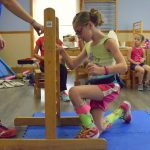Posts Tagged ‘Gravity’
Gravity and Cerebral Palsy: How it Affects your Child

Gravity is powerful.
You might be wondering: why is gravity special to people with cerebral palsy? Gravity affects everyone, right?
It’s true that gravity affects everyone. Gravity is where our muscle strength comes from. Think about typical development: all major milestones related to movement are different versions of working against gravity. Pushing up to hands and knees. Pulling to sit. Pulling to stand. Those are all movements against gravity, right? Gravity is the force that our muscles are pushing against, which is where muscle strength comes from. Think about how weak astronauts are when they return from a long trip outside the atmosphere: it’s because their muscles have very little opportunity to fight against something.
Gravity’s Affect on Individuals with Cerebral Palsy
Gravity affects kids with cerebral palsy in several ways. First, because their muscles aren’t quite as strong and have a harder time coordinating, it’s harder to fight against gravity to complete those major milestones. As a result, kids with CP spend more time in positions that are gravity dependent. This means that unless the right positioning equipment is used, young kids with CP tend to spend more time either lying down or lying back in a reclined position. This simple factor of not being in an upright position can have lasting effects on alignment. Did you know that this affects rib cage development? When we are born, our ribs are in a horizontal position. As we move through typical milestones to be able to sit and stand, gravity pulls our ribs so they angle down. Go ahead – feel your ribs right now and you’ll feel that they are pointing down. This is the ideal position for our ribs to support our lungs as they move out and in for normal breathing. If kids with cerebral palsy aren’t given the opportunity to be in an upright position as they grow, the ribs will stay horizontal which makes breathing harder.
Another major way that gravity affects many kids with CP is later in life during walking. “Crouch gait” is a very common feature of CP, and it’s pretty much what it sounds like: the child walks with their knees bent. There are several causes for this type of walking pattern, like growth spurts and spasticity, but gravity is also a major influence. Because gravity is pulling the body down, the knees bend, and leg muscles have to be strong enough to overcome that pull. Since kids with CP tend to have weaker muscles, gravity might be so strong that the knees are not able to straighten out.
Those are just two of the biggest ways that gravity affects kids with CP, but there are so many more since every movement we do is done against gravity (unless we are swimming, or happen to be in outer space!). Even if we are just sitting, our head and torso need to work to stay upright.
So what do we do about it?
The first thing is to be sure to get the right equipment from an early age. Children who are not sitting by 6 months should get adaptive equipment to allow them to sit upright, and if they are not standing by 12 months they should get equipment that supports them in a standing position.1 Adaptive equipment will allow them to be positioned against gravity, which not only supports correct rib cage alignment, but also helps them work on trunk and neck control, and allows them some opportunity to bear weight to help keep their bones strong.
The second thing is, of course, therapy! An intense motor program like what is offered at the Center for Independence will work on strengthening muscles to be able to overcome gravity and will address their ability to do all the antigravity movements of pulling to sit, pulling to stand, walking, and so on.
Share Your Thoughts on This Topic
- Have you ever thought about how gravity affects your child’s movement and alignment?
- Does this change how you think about using equipment with your child?
- What questions do you have about this concept?
Share your thoughts on our Facebook page!
Sources: 1. Gericke, T. (2006). Postural management for children with cerebral palsy: Consensus statement. Developmental Medicine & Child Neurology, 48, 244.
